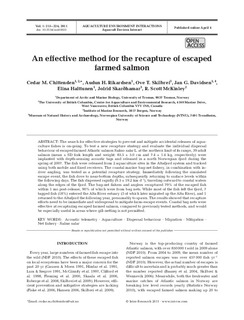| dc.description.abstract | The search for effective strategies to prevent and mitigate accidental releases of aquaculture
fishes is on-going. To test a new recapture strategy and evaluate the individual dispersal
behaviour of escaped farmed Atlantic salmon Salmo salar L. at the northern limit of its range, 39 adult
salmon (mean ± SD fork length and weight: 85.5 ± 5.0 cm and 7.4 ± 1.4 kg, respectively) were
implanted with depth-sensing acoustic tags and released in a north Norwegian fjord during the
spring of 2007. The fish were released from 2 aquaculture sites in the Altafjord system and tracked
using both mobile and fixed receivers. The coastal marine bag-net fishery, in combination with inriver
angling, was tested as a potential recapture strategy. Immediately following the simulated
escape event, the fish dove to near-bottom depths, subsequently returning to surface levels within
the following days. The fish dispersed rapidly (9.5 ± 19.2 km d–1), traveling outward to coastal waters
along the edges of the fjord. The bag-net fishers and anglers recaptured 79% of the escaped fish
within 1 mo post-release, 90% of which were from bag nets. While most of the fish left the fjord, 7
tagged fish (18%) entered the Alta River estuary (3 of which later migrated up the Alta River), and 1
returned to the Altafjord the following year, presumably to spawn. The results showed that recapture
efforts need to be immediate and widespread to mitigate farm-escape events. Coastal bag nets were
effective at recapturing escaped farmed salmon, compared to previously tested methods, and would
be especially useful in areas where gill-netting is not permitted. | en_US |
